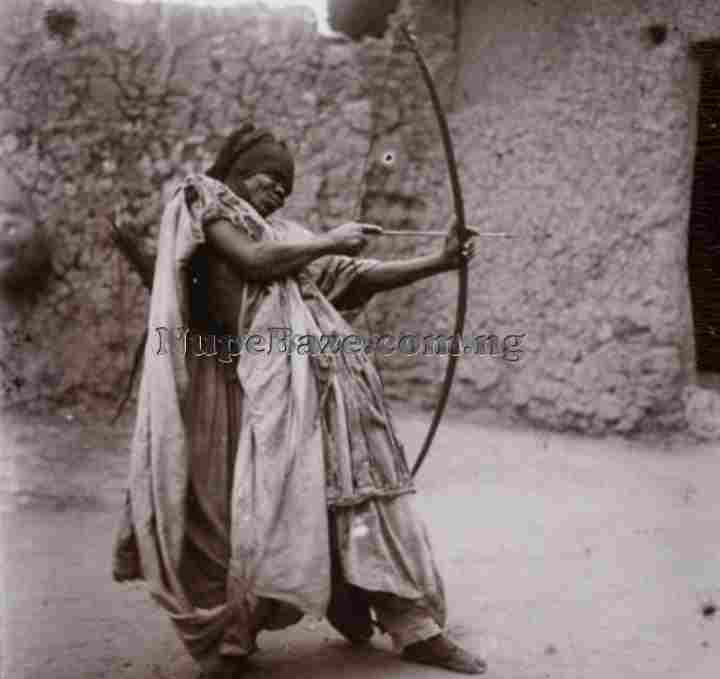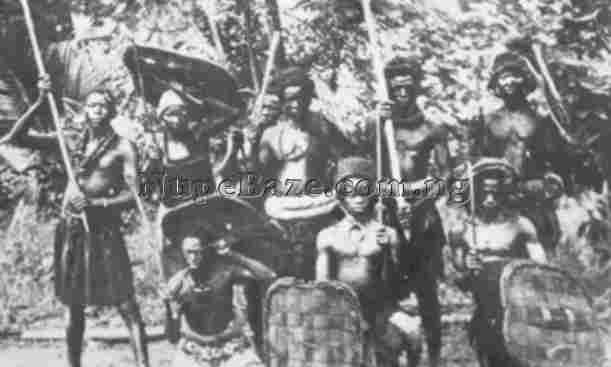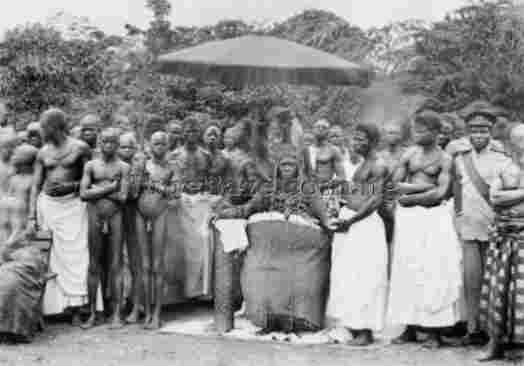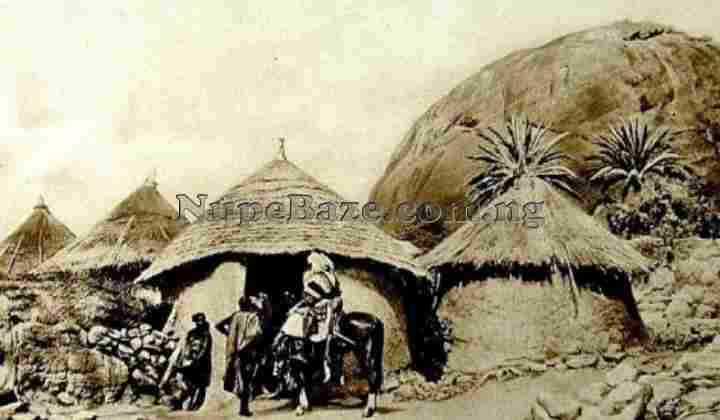Some years back before 1500, many of modern Nigeria settlement’s was divided into states identified with contemporary ethnic groups names. These early states included the Nupe Kingdom, Igala Kingdom, Kanem-Borno Empire, Igbo Kingdom of Nri , Benin Kingdom, Oyo Empire the Yoruba city-states including the Kingdom of Ife, and the Hausa States.
Numerous small states to the west and south of Lake Chad were absorbed or displaced in the course of the expansion of Kanem , which was centered to the northeast of Lake Chad. Bornu, initially the western province of Kanem, and it were became independent in the late 14th century.
Below we are going to list out top 10 Oldest Tribes In Nigeria and their location’s and also their brief histories
1. Nupe Tribe

[Old Picture Of Nupe Worrior’s]
The Nupe tribe are one of the most oldest tribe in Nigeria according to Sir S.F Nadel which wrote on his Book Title “The Black Byzantium, The Kingdom Of Nupe People” this ethnic is the root of Nigeria art and cultural affinity, most dialects in Middle Belt of Nigeria trace their history to Nupe people.
The majority of this tribe can be found in Niger state and and also Kwara state, Kogi state and Federal Capital Territory (FCT Abuja).
The main Nupe people are categorized into 5 Dialects which are the Bassa-Nge, Kakanda, Kupa, Dibo/Abawa and the Gana-Gana. Other similar tribes are the Igala tribe, Gbagyi tribe, Ebira tribe and the Koro tribe.
These tribes are one of oldest tribe and brave, e.g Notable people like General Mamman Jiya Vatsa, Air Vice Marshal John Nmadu Yisa Doko, Captain Samanja, Lieutenant Colonel Muhammad Abu Ali.

[Nupe Worrior Holding Archery]
The old Central Nupe Kingdom was established in the middle of the 15th century in a basin between the Niger state and Kaduna rivers in what is now central Nigeria. Early history is mostly based on verbally-transmitted legends. King Jibiri, who reigned around 1770, was the first Nupe king to become Muslim. Etsu Ma’azu brought the kingdom to its period of greatest power, dying in 1818.
During that period the Fulani were gaining power across Northern Nigeria. After Ma’azu’s death and during the subsequent wars of succession the Nupe Kingdom came under the control of the Gwandu Emirate.

[Nupe Soldier Of Etsu Nupe On Horse Back 1927]
Masaba, son of the Fulani leader Mallam Dendo and a Nupe mother, gained power in 1841. Faced with revolt by one of his Generals, Masaba allied with the former Etsu Nupe, Usman Zaki, to recover control. Usman Zaki was enthroned as Etsu Nupe at Bida, and after his death around 1859 Masaba again became ruler until 1873.

[One Of Nupe Soldier Of Etsu Nupe With His Sword & Horse 1945]
During his second period of rule, Masaba established the Bida Emirate as an important military power, steadily expanding its territory at the expense of its neighbors to the south and east.
His successors retained control until 1897, when British Niger state Company troops finally took Bida and established a puppet ruler.
The Bida emirate became subject first to the British colonial regime, then to the independent state of Nigeria, with its rulers playing an increasingly ceremonial role.
2. Igala Tribe

[Igala Warrior’s]
Igala are an ethnic group of Nigeria, they are also one of the Oldest tribe in the country. The former Igala Kingdom, is an approximately triangular area of about 14,000 km 2 in the angle formed by the Benue and Niger state rivers.
The area was formerly the Igala Division of Kabba province, and is now part of Kogi State. The former capital is Idah in Kogi state.
Igala tribe is one of the oldest tribe in Nigeria with brave and worrior men’s.

[The Old Picture Of Attah Of Igala Kingdom]
The first “Ata”, the title given to the ruler of Igala kingdom, was Ebule-Jonu, a woman; she was succeeded by her brother Agana- Poje, the father of Idoko. Idoko would later succeed him as Ata, and had two children Atiyele and Ayegba om’Idoko (Ayegba son of Idoko).
Atiyele the first son of Idoko migrated eastward of the kingdom to establish Ankpa kingdom while Ayegba the second son of Idoko succeeded his father as Ata’Gala. He led a war against the Jukun, which resulted in victory.

[Old Picture Of Igala Man On Horse Back]
Idakwo Micheal was appointed as the new Ata in December 2012. The ata-ship of Igala rotated among four branches of the royal clan. Igala Kingdom was founded by Abutu- Eje in the 16th century. The kingdom was ruled by nine high officials called the Igala Mela who are custodians of the sacred Earth shrine.
The Igala mega state attained the height of its fame during the mid-17th century. The Idah-Benin war (1515-1516) was a war of mutual independence.
The Igala state reached its political and commercial supremacy afterwards, when it became a leading exporter of choral beads, horses, medicine, skills and of course, slaves to the coastal region.
3. Kanuri Tribe

[Kanuri People At Old Bornu Kingdom]
Kanuri people are one of the oldest tribes in Nigeria, they have several subgroups, and identify by different names in some regions. The Kanuri language was the major language of the Bornu Empire and remains a major language in southeastern Niger, northeastern Nigeria and northern Cameroon, but in Chad it is limited to a handful of speakers in urban centers.
The largest population of Kanuri reside in the northeast corner of Nigeria , where the ceremonial Emirate of Bornu traces direct descent from the Kanem-Bornu empire, founded sometime before 1000 CE. Some 3 million Kanuri speakers live in Nigeria, not including some 200,000 speakers of the Manga or Mangari dialect.
The Nga people in Bauchi State trace their origins to a Kanuri diaspora. In the early 1980s, the Kanembu constituted the greatest part of the population of Lac Prefecture, but some Kanembu also lived in the Chari-Baguirmi Prefecture .
Once the core ethnic group of the Kanem-Borno Empire, whose territories at one time included northeastern Nigeria and southern Libya, the Kanembu retain ties beyond the borders of Chad. For example, close family and commercial ties bind them with the Kanuri of northeastern Nigeria.

[Oldest Bornu Empire]
Within Chad, many Kanembu of Lac and Kanem prefectures identify with the Alifa of Mao, the governor of the region in precolonial times. Originally a pastoral people, the Kanuri were one of many Nilo-Saharan groups indigenous to the Central South Sahara, beginning their expansion in the area of Lake Chad in the late 7th century, and absorbing both indigenous Nilo- Saharan and Chadic (Afro-Asiatic) speakers.
According to Kanuri tradition, Sef, son of Dhu Ifazan of Yemen , arrived in Kanem in the ninth century and united the population into the Sayfawa dynasty . This tradition however, is likely a product of later Islamic influence, reflecting the association with their Arabian origins in the Islamic era. Evidence of indigenous state formation in the Lake Chad area dates back to circa 800 BCE at Zilum.
4. Gbagyi Tribe

[Old Picture Of Gbagyi People Playing Traditional Guiter]
Gbagyi people are one of the oldest tribe in Nigeria. They are known to be peace-loving, transparent and accommodating people. Northerners are fond of saying in Hausa language muyi shi Gwari Gwari , “let’s do it like the Gbagyi” or “in the Gbagyi way”. According to Tanko Chigudu, the Gbagyi people have emerged as a unique breed among Nigerians: their culture shows how much they have come to terms with the universe.
Daily they aspire to give life a meaning no matter the situation in which they find themselves. According to C.O. Adepegba, in relation to the artistic traditions of Southern Nigeria, Nok terracotta’s have often stylistically compared.
But the area of their discovery seems to be in the middle of a broad belt of various terracotta productions w hich appears like a band across Nigeria from her western to the Eastern borders. Some of the other terracotta traditions found in the belt are fairly old.
The one from Daima (close to Northern Eastern border of Nigeria) has been dated to between 600 B.C. and A. D 1100, with the one of Yelwa been dated to between the second and the seventh centuries A.D close to Nok terracotta’s as those traditions are in time and shape, they are in forms and style quite different from the Nok find as well as from each other.
Islam first came to the Gbagyis in the 19th century during the Sokoto Jihad of 1804 by Usman Danfodio, while Christianity came in the 20th century through the southerners.
Islam was able to gain more converts than Christianity, the reason for this w as that the practices encouraged by the Gbagyi religion conformed with Islam, such as polygamy, devotion, using of rings or amulets.
These similarities made it easy for the Gbagyi’s to receive Islam whole-heartedly. But regardless of the twin influe nces of Islam and Christianity the Gbagyi people still practice their Kunu.
Gwari traced it origins back to Ancinet Bornu they were part of the Bornu Empire as early as the 1750 along with the Koro because of conflict in Bornu, the Gbagyi resistance to coversion to Islam the first hunter who was a Gwari hunter went for hunting in Paikokun land a thick forest it is said that Paikokun was the name of the mountain where the first settlers inhabited.
5. Benin Tribe

[The Old Picture Of Edo/Bini Kingdom]
The Edo or Benin people are one of the oldest tribe in Nigeria and they are also an Edoid ethnic group primarily found in Edo State , Nigeria. They speak the Edo language and are the descendants of the founders of the Benin Empire.
They are closely related to other ethnic groups that speak Edoid languages, such as the Esan, the Afemai , the Isoko ,and the Urhobo. The name “Benin” (and “Bini”) is a Portuguese corruption, ultimately from the word “Ubini”, which came into use during the reign of Oba (ruler) Ewuare the Great, c. 1440.
“Ubini”, an ancient Edo word meaning beautiful people, was used to describe the royal administrative centre or city or capital proper of the kingdom, Edo. Ubini was later corrupted to Bini by the mixed ethnicities living together at the centre; and further corrupted to Benin around 1485 when the Portuguese began trade relations with Oba Ewuare.
Edo people can be found in Nigeria’s Edo State which got its name from the primary inhabitants of the region’s most notable historical conglomeration, Benin City , which is also the central capital homeland of the Edo people.
Edo people also have many related groups in their immediate surroundings also encompassed by the political and administrative borders of Edo state.
Most of these groups have traced their history back to the historical city center off the Benin people, Benin City . Examples of such adjacent groups include various Afemai sub-groups, the Esan people of Edo state and the Akoko Edo people situated on the state’s northern borders.
Edo state was formerly part of the old Bendel state of early post-colonial Nigeria, also known as the Mid-Western Region, Nigeria . This region’s influence and culture reflects that of the Edo, Urhobo, Esan and other Edo related peoples.
6. Yoruba Tribe

[Old Picture of Oba, The King of Oyo Kingdom]
The Yoruba people are also among the oldest tribe in Nigeria, the word ( Yoruba: Ọmọ Káàárọ̀-oòjíire are an ethnic group that inhabits western Africa , mainly the countries of Nigeria , Benin , and Togo .
The Yoruba constitute around 35 million people in Africa. The vast majority of the Yoruba population is from Nigeria , where the Yoruba make up 15.5% of the country’s population, making them one of the largest ethnic groups in Africa . Most Yoruba people speak the Yoruba language , which is the Niger-Congo language with the largest number of native speakers.
As an ethnic description, the word “Yoruba” (or more correctly “Yaraba”) was originally in reference to the Oyo Empire and is the usual Hausa name for Oyo people as noted by Hugh Clapperton and Richard Lander.
It was therefore popularized by Hausa usage and ethnography written in Ajami during the 19th century by Sultan Muhammad Bello. The extension of the term to all speakers of dialects related to the language of the Oyo (in modern terminology North-West Yoruba) dates to the second half of the 19th century.
It is due to the influence of Bishop Samuel Ajayi Crowther , the first Anglican bishop in Nigeria. Crowther was himself an Oyo Yoruba and compiled the first Yoruba dictionary as well as introducing a standard for Yoruba orthography.
The alternative name Akú , derived from the first words of Yoruba greetings (such as Ẹ kú àárọ? “good morning”, Ẹ kú alẹ? “good evening”) has survived in certain parts of their diaspora as a self- descriptive, especially in Sierra Leone.
The Yoruba are among the most urbanized people in Africa. For centuries before the arrival of the British colonial administration most Yoruba already lived in well structured urban centres organized around powerful city-states ( Ìlú) centred around the residence of the Oba. In ancient times, most of these cities were fortresses, with high walls and gates.
Yoruba cities have always been among the most populous in Africa. Archaeological findings indicate that Òyó-Ilé or Katunga, capital of the Yoruba empire of Oyo (fl. between the 11th and 19th centuries CE), had a population of over 100,000 people.
For a long time also, Ibadan , one of the major Yoruba cities and founded in the 1800s, was the largest city in the whole of Sub Saharan Africa . Today, Lagos (Yoruba : Èkó ), another major Yoruba city, with a population of over twenty million, remains the largest on the African continent.
7. Hausa Tribe

[Old Picture Of Hausa Town in Sokoto state]
Predominantly Hausa-speaking communities are scattered throughout West Africa and on the traditional Hajj route north and east traversing the Sahara , with an especially large population in and around the town of Agadez. Other Hausa have also moved to large coastal cities in the region such as Lagos , Port Harcourt, Accra, Abidjan , Banjul and Cotonou as well as to parts of North Africa such as Libya over the course of the last 500 years. The Hausa, traditionally live in small villages as well as in precolonial towns and cities where they grow crops, raise livestock including cattle as well as engage in trade, both local and long distance across Africa.
They speak the Hausa language , an Afro-Asiatic language of the Chadic group. The Hausa aristocracy had historically developed an equestrian based culture. Still a status symbol of the traditional nobility in Hausa society, the horse still features in the Eid day celebrations, known as Ranar Sallah (in English: the Day of the Prayer).
Daura city is the cultural center of the Hausa people. The town predates all the other major Hausa towns in tradition and culture. Daura, in northern Nigeria , is the oldest city of Hausaland. The Hausa of Gobir , also in northern Nigeria, speak the oldest surviving classical vernacular of the language.
Historically, Katsina was the centre of Hausa Islamic scholarship but was later replaced by Sokoto stemming from the 17th century Usman Dan Fodio Islamic reform.
The Hausa are culturally and historically closest to other Sahelian ethnic groups, primarily the Fula ; the Zarma and Songhai (in Tillabery , Tahoua and Dosso in Niger ); the Kanuri and Shuwa Arabs (in Chad, Sudan and northeastern Nigeria); the Tuareg (in Agadez , Maradi and Zinder ); the Gur and Gonja (in northeastern Ghana , Burkina Faso , northern Togo and upper Benin ); Gwari (in central Nigeria); and the Mandinka, Bambara, Dioula and Soninke (in Mali, Senegal , Gambia , Ivory Coast and Guinea ).The Nok culture appeared in northern Nigeria around 1000 BCE and vanished under circumstances around 300 AD in the region of West Africa.
It is believed to be the product of an ancestral nation that branched to create the Hausa, the people of Gwandara language , Biram, Kanuri , Nupe peoples, the Kwatarkwashi Culture of Tsafe or Chafe in present-day Zamfara State located to the North west of Nok is thought to be the same as or an earlier ancestor of the Nok. Nok’s social system is thought to have been highly advanced.
The Nok culture is considered to be the earliest sub-Saharan producer of life-sized Terracotta .
8. Igbo Tribe

[Ancient Igbo People At Onitsha]
The Igbo people are also among the most oldest tribe in Nigeria, the (English: /ˈiːboʊ/ EE-boh ,also US : / ˈɪɡboʊ/ ; also spelled Ibo and formerly also Iboe, Ebo , Eboe , [9] Eboans , Heebo; natively Ṇ́dị́ Ìgbò [ìɡ͡bò] ( listen )) are a meta-ethnicity native to present-day south- central and southeastern Nigeria .
Large ethnic Igbo populations are found in Cameroon, Gabon, and Equatorial Guinea, as well as outside Africa. There has been much speculation about the origins of the Igbo people, as it is how exactly the group came to form.
Geographically, the Igbo homeland is divided into two unequal sections by the Niger state River – an eastern (which is the larger of the two) and a western section.
The Igbo people are one of the largest ethnic groups in Africa. The Igbo language is a part of the Niger-Congo language family. It is divided into numerous regional dialects and somewhat mutually intelligible with the larger “Igboid” cluster.
The Igbo homeland straddles the lower Niger state River, east and south of the Edoid and Idomoid groups, and west of the Ibibioid (Cross River) cluster.
Before the period of British colonial rule in the 20th century, the Igbo were a politically fragmented group, with a number of centralized chiefdoms such as Nri, Aro Confederacy, Agbor and Onitsha .
Frederick Lugard introduced the Eze system of “warrant chiefs”. Unaffected by the Fulani War and the resulting spread of Islam in Nigeria in the 19th century, they became overwhelmingly Christian under colonization. In the wake of decolonisation, the Igbo developed a strong sense of ethnic identity.
During the Nigerian Civil War of 1967–1970, the Igbo territories seceded as the short-lived Republic of Biafra. The Movement for the Actualization of the Sovereign State of Biafra, a sectarian organization formed in 1999, continues a non-violent struggle for an independent Igbo state.
9. Ebira Tribe

[Old Picture Of Ebira Women]
The Ebira people are an ethno- linguistic group of central Nigeria . Many Ebira people are from Kogi State, Kwara State , Nasarawa State and Edo State . Okene was said to be the administrative centre of the Ebira-speaking people in Kogi state before Kogi was formed from Kwara, not far from the Niger state – Benue confluence. Since the formation of the state, the Ebira Ta’o people are found in four local governments namely: Adavi , Ajaokuta , Okehi and Okene each with their administration headquarters.
During the conquest of Hausaland by the armies of he religious and political leader Uthman Dan Fodio , the Ebiras came under a state of conflict with Fulani warlords to the north and west.
In the middle of the nineteenth century, two major communities, Igu (Koton Large) as it was called by Hausa, it means strong land because they fought to conquest them but never succeed and were not conquered.] Between 1865 and 1880, they battled, under the leadership of a warlord, Achigidi Okino, with jihadists called Ajinomoh who were from Bida and Ilorin.
However, the Ebiras were not conquered by the Fulanis, helped in part by the natural defenses of their hilly environment.
Ebira Koto are found in Kogi and KotonKarfe LGA, Bassa LGA, Lokoja in Kogi and Abaji LGA in the Federal Capital Territory, and Nasarawa in Toto LGA. Another, the Eganyi are found in Ajaokuta LGA. And the Etuno can be found in Igarra town of Akoko-Edo LGA, Edo state.
The migration of Ebira people to the present region is mostly surmised by oral history. However, most versions trace the migration from the Jukuns of the Kwararafa state, north of the Benue River and in present-day Taraba State .
One of the relics of their trace from Kwararafa is the Apete stool, their symbol of authority and identity as a group within the kingdom, brought along and kept in a place in Opete (deriving its name from the stool), in present-day Ajaokuta.
The Apete is presently the title instrument of Ozumi of Okene. After migration from Kwararafa, they originally settled with the Igalas and both groups lived together for about 300 years. A dispute between the two groups led to a parting of ways, and the Ebiras moved southwest of the River Niger state to their ancestral home called Ebira Opete an area around Ajaokuta .
Other groups later moved south to found Okengwe, Uboro and Okehi. Historically, these Ebiras communities were autonomous units without a central king or recognized royal families but were managed by leaders of lineages in a type of gerontocracy.
10. Tiv Tribe

[The Ancient Tiv People]
The Tiv say they emerged into their present location from the southeast. It is claimed that the Tiv wandered through southern, south-central and west-central Africa before arriving at the savannah lands of West African Sudan via the River Congo and Cameroon Mountains and settled at Swemkaragbe the region adjoining Cameron and Nigeria in the beginning of 1500 CE.
“Coming down,” as they put it, was in batches, some moved southward across Obudu mountains others moved northward spreading over Mdema and Waka district, while others moved into core benue valley present day core Central Nigeria.
These dispersions took place in the early 1500 CE to 1600 CE, over time as social interactions began and new migrants came into Nigeria. The Tiv people were a free people without a king; hence every clan or kindred was administered by the eldest man called “Orya” they were amongst the first inhabitants of the Benue Valley according to mark Cartwright record of Bantu migration before other tribes finally migrated to join them, Due to their peaceful disposition and dispersed nature of living.
With no Central government nor king, they posed no threat to new migrants to the region who cohabited with them until the coming of the Europeans. The Europeans first contact with Tiv was in the 18th century.
Note that the time of encounter with the European does not means their time of migration, their late recognition was due to the lack of kingship which became a big disadvantage to Tiv in Nigeria because the colonial masters prefer working with kings, so when the Tiv were found on the banks of the Benue River and were discovered to be distinct from other ethnic minorities and were the major occupants of the Benue Valley. That was when kinship was later introduced to Tiv people by the European in the 1940s Benue.
In 1879 their occupation of the riverbanks was about the same as in 1950. British forces entered Tivland from the east in 1906, when there was tension between Tiv and other minorities within the Benue valley. The Tiv said in 1950 that they had defeated this British force, then later invited the British in for negotiations. The southern area was penetrated from the south; what southern Tiv refer to as “the eruption” of the British there occurred in 1911.
